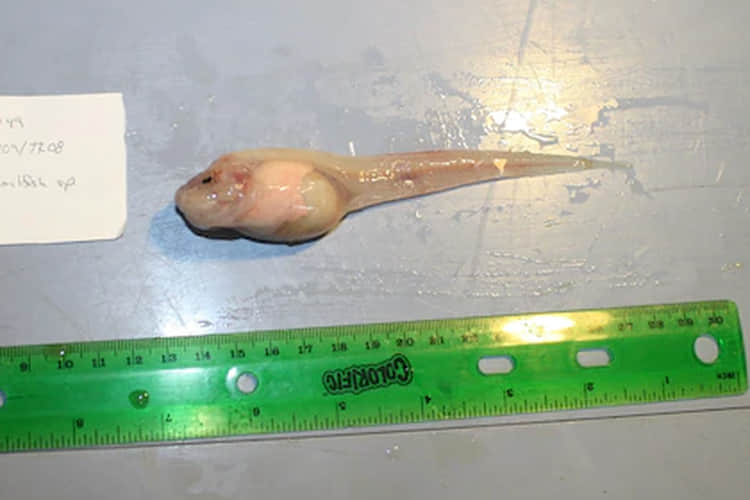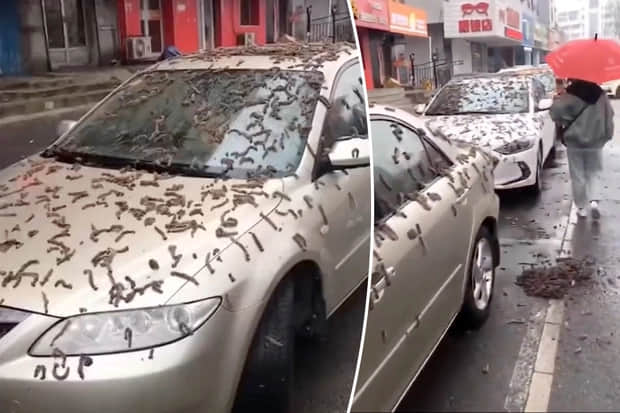Caecilian, legless amphibians with a snake-like appearance, are the first terrestrial vertebrates that can secrete venom after their bite.

According to the New York Times, if there was an animal that was a cross between a worm and a snake, it would probably look like a caecillian. It is a legless animal, neither a worm nor a snake, and is a soil-dwelling amphibian found in many tropical regions around the globe.

Having spent most of their lives underground, caecilian are very rarely found, and so we know very little about them. This is why Carlos Jared, a biologist at the Butantan Institute in Sao Paulo, Brazil, has spent nearly three decades studying this mysterious animal.


Catching a caecilian usually takes hours, says Jared, because it takes time to dig, but shovel gently into the ground because otherwise it’s very likely that the blade will accidentally cut the animal in half.

When you see one, you have to “jump right into it,” says Dr. And often he would have to struggle with the animal to fit it in his pocket. Depending on the branch, a caecilian can be anywhere from 5cm to 1.5m long, and many times they have escaped Mr. Jared’s hands at the last minute, thanks to an oily substance secreted from the skin.

But Dr Jared also says the caecilian’s mystery and puzzling biology make the grueling hunt worth it. The latest discovery by the team led by Jared, published in the science journal iScience, shows that the mouths of caecilians may include teeth capable of secreting venom, like those of snakes.
The discovery marks the first time that venom has been found in the mouth of an amphibian, a class of animals whose evolutionary history predates snakes by more than 100 million years. This also shows that the caecilian was the first animal capable of injecting venom into the first object on Earth.
Like many other amphibians, caecilians have long been thought to possess venom but passively, meaning that if another animal eats them, they will be poisoned. Some snakes are considered active venom, meaning they can inject venom into their subjects.
So Pedro Luiz Mailho-Fontata, who was doing postdoctoral research with Jared, was surprised to discover a series of sacs containing solution at the base of the caecilian’s teeth.
“This seemed different,” Mr. Luiz recalls.
The animal is not a snake, but the bite has a formidable venom – Photo 2.
Fluid-filled sacs underneath the caecilian teeth. Photo: Carlos Jared.
After studying the mouths of young caecilians, Luiz determined that the sacs containing the solution grew out of the same tissue that makes teeth.
Tooth tissue is also the starting point of venom glands in snakes, which may help explain the purpose of the newly discovered fluid-filled sacs. Because they have no limbs to fend off predators or prey, animals such as snakes and caecilian have to rely heavily on their heads.
Dr. Jared and his team have not yet performed a study to dig deep into the structure of the solutions contained in the caecilian subdental sacs, although preliminary testing suggests they contain the same protein as found. found in snake and insect venom.
A few years ago, during a visit to the laboratory in London, Marta Maria Antoniazzi, co-author of the study, picked up a tiny caecilian and it immediately bit her hand.
“It hurts, it hurts,” said Antoniazzi, adding that it took a long time for the tiny bite to close.
Although caecilians are widely distributed in the tropics, they are difficult to find. Like common worms, this species will hide deep in the ground. Biologist Carlos Jared says it takes hours of digging to find caecilians.
This amphibian can be up to 1.5m long, the whole body is covered with lubricating mucus to make it easy to move and retain moisture. A special thing is that in the mouth of caecilians there are many teeth that grow in 3 different arches and are filled with venom.
After studying the venom of caecilians amphibians, scientists showed that it is quite similar to the venom of snakes. This venom is considered a weapon that caecilians use to kill prey with a single bite.
Even so, amphibian caecilians will not pose a danger to humans because they only really feed underground. They capture other small amphibians and do not use venom for defense. However, it is not good if we expose our bodies to the poison of the caecilians.
Caecilians were first discovered in 1935, but the discovery of venom in their teeth and saliva was an unprecedented feat. Scientists are still studying this strange worm-like amphibian.
For the first time, researchers have found evidence of venom glands in caecilian, legless amphibians with a snake-like appearance.
Siphonops annulatus curled up on the forest floor. Photo: Sci Tech Daily.
The researchers describe special glands along the teeth of the ringed caecilian species (Siphonops annulatus) with a biological origin and function similar to the venom glands of snakes in a study published July 3 in the journal iScience. If further study helps confirm those glands contain venom, the caecilian could become the oldest terrestrial vertebrate with oral venom glands.
Caecilian are strange creatures, they are almost blind, using a combination of facial tentacles and mucus to find their way in underground burrows. “This animal secretes two types of compounds, the tail secretes toxins while the head produces mucus that helps them crawl on the ground,” said biologist Carlos Jared, director of the Laboratory of Structural Biology at the Butantan Institute in São Paulo, Brazil, said. “Since caecilian are one of the least studied vertebrates, their biology is a black box full of surprises.”
Pedro Luiz Mailho-Fontana, a postdoctoral fellow in the Laboratory of Structural Biology and lead author of the study, found a series of small fluid-filled glands in the upper and lower caecilian jaws, accompanied by long tubes. at the root of the tooth. Through analysis of embryos, Mailho-Fontana found that the oral glands originate in a tissue distinct from the toxic glands and the caecilian skin mucus.
Mailho-Fontana et al. suspect that caecilian can use secretions from glands in the mouth to incapacitate prey. Since caecilian have no legs, their mouth is the only tool they have for hunting. According to Marta Maria Antoniazzi, an evolutionary biologist at the Butantan Institute and co-author of the study, caecilian can activate glands in the mouth when biting, and integrate specialized biomolecules in secretions.
Preliminary chemical analysis of secretions from caecilian oral glands revealed increased activity of phospholipase A2, a protein common in animal poisons, and even higher levels than in some species of rattlesnakes. It is possible that the caecilian represent a more primitive form of venom gland evolution. Snakes appeared from the Cretaceous period about 100 million years ago, but the caecilian date back much longer, about 250 million years.





